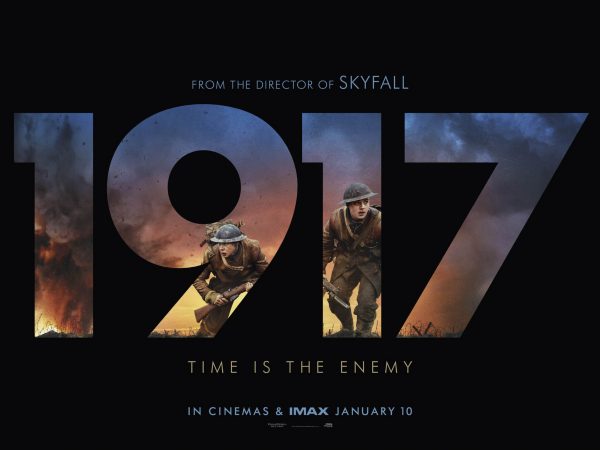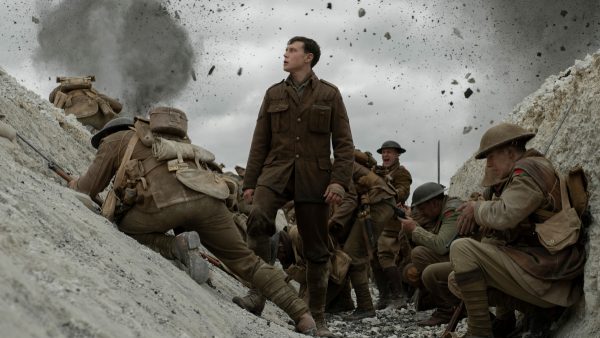1917, 2019.
Directed by Sam Mendes.
Starring George MacKay, Dean-Charles Chapman, Colin Firth, Mark Strong, Benedict Cumberbatch, Andrew Scott, Claire Duburcq, Daniel Mays, Richard Madden and Adrian Scarborough.
SYNOPSIS:
Two young British soldiers in the trenches of the First World War are sent on a dangerous journey to prevent another unit from walking straight into a potentially fatal German trap.
This weekend, Sam Mendes’ wartime drama 1917 surprised many awards prognosticators when it beat out the likes of The Irishman and Marriage Story to win the ‘Best Picture – Drama’ award at the Golden Globes. On the heels of that success, the movie is making its way into UK cinemas with expectations on its shoulders. And for the most part, Mendes is able to vault that high bar with this technically masterful and nail-bitingly tense tale of a race against time in the trenches of France during the First World War.
Young soldiers Schofield (George MacKay) and Blake (Dean-Charles Chapman) are despatched on a crucial mission to deliver a very important letter. The Germans have faked a retreat, hoping to spring a trap on hundreds of British men – including Blake’s older brother – who are following them in the hope of securing a decisive blow. Schofield and Blake are told by General Erinmore (Colin Firth) that they “should meet no resistance” on their journey, but their path quickly proves to be more arduous and treacherous than anyone imagined.
The big idea at the centre of 1917 is that, in the vein of Birdman, the entire thing is stitched together to provide the appearance of a single take, with the exception of a cut to black at one crucial and shocking moment. The skill and flair required on the part of Mendes and legendary cinematographer Roger Deakins to make this work is undeniable, even if the concept has lost some of its lustre in the wake of Birdman‘s Oscar win and other movies like Silent House, as well as that one episode of Mr Robot on TV. Even Mendes has experimented with the style before in the stunning opening scenes of Bond movie Spectre.
It might not be as original as it once was, but this technique provides a white-knuckle tension throughout the movie. The focus cleaves tightly to the two central characters as they experience hardships and horrors that are unimaginable outside of conflict, from trip wires both literal and figurative to a scene in which a hand previously snagged in barbed wire plunges into the open chest cavity of a rotting corpse. Mendes doesn’t skimp on the visceral grossness of the First World War and its trenches, with Chapman’s character commenting of a German dorm that “even their rats are bigger than ours”.
The two central performances are terrific, with MacKay in particular throwing himself wholeheartedly into the mud, blood and chaos of the conflict. It’s a performance of intense physical endurance and keenly felt emotional turmoil, with one scene of him collapsing to his knees pregnant with every feeling imaginable. The moment is packed with fatigue of course, but MacKay also communicates the weight of responsibility. He knows that the lives of hundreds of others rest on his ability to complete his mission. MacKay has been a standout performer since the days of Sunshine On Leith and, if there’s any justice, he’ll be able to take on some more meaty roles in the future.
Despite its one-shot style, 1917 is surprisingly varied in its visual style. Mendes and Deakins move in and out of the trenches, mixing the oozing filth of those environs with the stark beauty of a serene French farm and the colourful conflagration of a town on fire. This is all accentuated by Thomas Newman’s exceptional score, which subtly amplifies every emotion and moment of tension. It’s so intricately woven into the action that its absence is almost more immediately noticeable than its presence.
The film is not, however, totally perfect. Mendes relies rather too heavily on a series of one scene cameos from A-list British talent, which often hinge on someone with their back to camera turning around so that the audience can cheer and nudge the person next to them. The only real exception is Andrew Scott, who has great fun in his scene as a sozzled squaddie who has basically resigned himself to the futility of fighting and his imminent death. Meanwhile, the likes of Firth, Benedict Cumberbatch and Mark Strong are utterly squandered, with Cumberbatch in particular set up as a Kurtz-like figure, only to ultimately end up much less interesting.
But there’s no denying that this is a bravura technical achievement from a filmmaking team at the peak of their talents. The technological approach feels a little more like a gimmick here than it arguably should, but the knot in your chest as you watch it is far more than that. 1917 is as much of an endurance test in the cinema as it seemingly was on the other side of the camera, and it’s one that lands with a grotesque, powerful punch.
Flickering Myth Rating – Film: ★ ★ ★ ★ / Movie: ★ ★ ★ ★
Tom Beasley is a freelance film journalist and wrestling fan. Follow him on Twitter via @TomJBeasley for movie opinions, wrestling stuff and puns.















